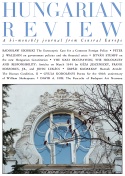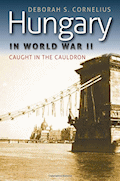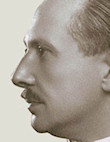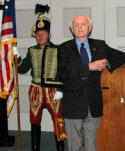 Volume V, No. 2: Frank Koszorus Volume V, No. 2: Frank Koszorus
"Reflections on March 19, 1944 and Its Aftermath:
A Perfect Storm of Tragedy and Folly"
The American Hungarian Federation's statement regarding the occupation of Hungary by Hitler on March 19, 1944 and its horrific consequences: "We are concerned that a political agenda has replaced a debate based on historical facts relating to the Hungarian Holocaust and Nazi Germany's invasion and occupation of Hungary," said Frank Koszorus, Jr., the Federation's president. "We condemn not only whitewashing but the blackening of this historical record as well. Both forms of revisionism does a great disservice to the memory of the victims of evil and those who opposed it at a treacherous time in Hungary's history. These considerations prompted us to issue our statement," he added. [read more]
 Volume V, No. 2: John O'Sullivan Volume V, No. 2: John O'Sullivan
Editorial Note
"'Yes', replied Clemenceau, 'future historians will say many things that we today might disagree with. But ...they will not say... that Belgium invaded Germany...' They do not say that Hungary occupied Germany."
Some years ago Simon Green, the English cultural critic, wrote a paper on the evolution of war monuments in Britain. Earlier monuments tended to be local and narrow in their ambit of concern. They memorialised the men of the village who had fought and died. And that was it. Ideally that spirit of reconciliation should animate monuments and memorials where it can.
It seems to us that something like this sentiment originally inspired the proposed monument to all the Hungarian victims of the German Occupation of 1944. But it has run up against the fact that different historical interpretations of the German Occupation and of Hungary’s role in the Second World War still divide Hungarians. A monument intended to reconcile thus risks becoming a further cause of division.
The fact that its unveiling has been postponed gives everyone the opportunity to consider how to restore its original purpose. Simon Green’s work tells us that the solution may be simply a matter of words. For, as Ataturk demonstrated, words can heal as well as hurt.
[read more]
 Volume V, No. 2: John Lukács Volume V, No. 2: John Lukács
"An Other Hungary Existed"
"Szent-Iványi was both witness and principal actor in Hungary’s very great tragedy. His documents and descriptions of those weeks and months are valuable for us..."
For many reasons, too long to detail or even sum up here, Hungary was a natural and expectable minor ally of the German Third Reich. Both of them were defeated and truncated after the First World War (Hungary lost two-thirds of its ancient kingdom). Hungary’s desire of revisionism had no results, while Hitler’s indeed did. In 1938 he annexed Austria, Hungary’s close neighbour. The effects of this condition were wide and deep, they included also a considerable empathy for the Third Reich among a large portion of Hungarians. But there was a minority among Hungarians, mostly among the upper classes, that opposed to such atendency. They included the former Prime Minister István Bethlen, whom Szent-Iványi had met years before, they had a mutual esteem for each other. And as early as 1936 something like a Hungarian Independence Movement was beginning to form, meaning primarily the maintaining of a considerable amount of Hungarian independence from Germany. Its very existence is extensively documented in this book. Szent-Iványi was in the midst of it. But to understand something of its difficulties is hardly separable from the complex nature of Hungarian politics and statesmanship during the Second World War. [read more]
 Volume V, No. 2: Géza Jeszenszky Volume V, No. 2: Géza Jeszenszky
"Hungary in the Second World War: Tragic Blunders or Destiny?"
"Horthy in his Memoirs wrote that when Hitler told him that Germany would occupy Hungary, he should have shot the dictator. Why did he not do that, he had a pistol on him..."
Among the many unfair or exaggerated criticisms Hungary has received recently it is often brought up that Horthy, Hungary’s Head of State (Regent) from 1920 to 1944, was an ally of Nazi Germany, who, with Hitler’s help, annexed territories from the neighbours, and permitted the murder of half a million Jewish Hungarians. Few of the journalists, let alone their readers, would take the trouble to look into the intricate story of how Hungary (together with all the states of Central Europe) became the victim first of Hitler and then of Stalin, and what was the background of the terrible crimes perpetrated during and immediately after the Second World War. Here is a summary of those fateful years. [read more]
 Volume III, No. 3: Frank Koszorus Volume III, No. 3: Frank Koszorus
"The Soldier Who Saved the Lives of Budapest's Jews: Col. Ferenc Koszorus." The United States, Hungary, Sweden and others are commemorating the centennial of the birth of Raoul Wallenberg. the Swedish diplomat who exhibited incredible heroism and saved tens of thusands of Hungarian Jews from deportation during the Holocaust. Less known is the courageous intervention of Col. Ferenc Koszorus and his loyal First Armored Division on July 6, 1944 to block the deportation of the more than 250,000 Jews of Budapest. In paying tribute to Col. Koszorus, former Congressman Tom Lantos, a survivor of the Holocaust, noted that the Koszorus intervention "permitted... Wallenberg, who arrived in Budapest on July 9, 1944, to coordinate his successful and effective rescue mission." Congressman Lantos' statement, as entered into the Congressional record. [read more]
[<< Back to All AHF News]
| Hungarian Review is available for purchase [directly from the publisher] or on AHF's Amazon Store 
Related Articles
 Hungary in World War II: Caught in the Cauldron by Deborah Cornelius, Fordham University Press, New York, 2011. Csaba Zoltani writes: "Deborah Cornelius’ Hungary in World War II: Caught in the Cauldron (Fordham University Press, New York 2011) gives an excellent overview of the events leading up to and the horrendous events of World War II in Hungary. The effect of the Treaty of Trianon, that without plebiscites, truncated Hungary and deprived it of its natural resources and forced a sizeable portion of its population to live under alien jurisdiction, set the political and sociological climate in Hungary from the 1920's on. [read more] or buy it now on AHF's Amazon Store! Hungary in World War II: Caught in the Cauldron by Deborah Cornelius, Fordham University Press, New York, 2011. Csaba Zoltani writes: "Deborah Cornelius’ Hungary in World War II: Caught in the Cauldron (Fordham University Press, New York 2011) gives an excellent overview of the events leading up to and the horrendous events of World War II in Hungary. The effect of the Treaty of Trianon, that without plebiscites, truncated Hungary and deprived it of its natural resources and forced a sizeable portion of its population to live under alien jurisdiction, set the political and sociological climate in Hungary from the 1920's on. [read more] or buy it now on AHF's Amazon Store! 
 4/16/2012 - Raoul Wallenberg Remembered on Capitol Hill. U.S. Congressman Harris recalls Col. Ferenc Koszorus, Sr., Hero of the Holocaust. AHF honors the millions of lives lost and the untold suffering caused by Nazism and Communism. But even during the horrors of WWII, stories of resistance to Nazi atrocities emerged. When Hitler's patience ran out with the conservative leaders in Budapest and their peace-feelers
and contacts with Western allies, Nazi Germany invaded Hungary in March 1944, drastically
changing the situation of Hungary and the Jewish community. [read more] 4/16/2012 - Raoul Wallenberg Remembered on Capitol Hill. U.S. Congressman Harris recalls Col. Ferenc Koszorus, Sr., Hero of the Holocaust. AHF honors the millions of lives lost and the untold suffering caused by Nazism and Communism. But even during the horrors of WWII, stories of resistance to Nazi atrocities emerged. When Hitler's patience ran out with the conservative leaders in Budapest and their peace-feelers
and contacts with Western allies, Nazi Germany invaded Hungary in March 1944, drastically
changing the situation of Hungary and the Jewish community. [read more]
 3/24/2009 - In 2009, as part of the Holocaust Memorial Month, the Embassy of Hungary sponsored the Carl Lutz and the Legendary Glass House in Budapest traveling exhibit in Washington, DC. The Carl Lutz Foundation, Hungarian American Coalition, Lantos Foundation for Human Rights and Justice, Mensch International Foundation and the Embassies of Switzerland and Israel are co-sponsors. The Federation believes it would be appropriate that the Embassy of Hungary, as a representative of all Hungarians, expand such exhibits to include Hungarian heroes of the Holocaust. [read more] 3/24/2009 - In 2009, as part of the Holocaust Memorial Month, the Embassy of Hungary sponsored the Carl Lutz and the Legendary Glass House in Budapest traveling exhibit in Washington, DC. The Carl Lutz Foundation, Hungarian American Coalition, Lantos Foundation for Human Rights and Justice, Mensch International Foundation and the Embassies of Switzerland and Israel are co-sponsors. The Federation believes it would be appropriate that the Embassy of Hungary, as a representative of all Hungarians, expand such exhibits to include Hungarian heroes of the Holocaust. [read more]
 9/13/2011 - Slovak President shamefully calls Janos Esterhazy, a hero of the Holocaust, a follower of Hitler. AHF continues call for rehabilitation of Janos Esterhazy, reacts to Slovak falsification of history... Esterhazy was the only member of the Slovak Parliament in 1942 who voted against expelling the Jews, setting an example which few dared to follow in the parts of Europe controlled by Adolf Hitler's Germany. He was detained by the Nazis and died in a communist prison. He is still classified as a war criminal in Slovakia. [read more] 9/13/2011 - Slovak President shamefully calls Janos Esterhazy, a hero of the Holocaust, a follower of Hitler. AHF continues call for rehabilitation of Janos Esterhazy, reacts to Slovak falsification of history... Esterhazy was the only member of the Slovak Parliament in 1942 who voted against expelling the Jews, setting an example which few dared to follow in the parts of Europe controlled by Adolf Hitler's Germany. He was detained by the Nazis and died in a communist prison. He is still classified as a war criminal in Slovakia. [read more]
AHF History
Congressional Record
 FERENC KOSZORUS: A HERO OF THE HUNGARIAN HOLOCAUST FERENC KOSZORUS: A HERO OF THE HUNGARIAN HOLOCAUST
HON. TOM LANTOS
(Extension of Remarks - May 26, 1994)
[Page: E1109]
HON. TOM LANTOS
in the House of Representatives
THURSDAY, MAY 26, 1994
(Tom Lantos, who died in February 2008 of esophageal cancer, was honored with the Presidential Medal of Freedom, the nation's highest civilian honor. He was also recipient of AHF's highest honor, the Col. Commandant Michael Kovats Medal of Freedom [read more])
- Mr. LANTOS. Mr. Speaker, this year marks the 50th anniversary of the Hungarian holocaust. I rise today to recognize one of the great heros of the Hungarian holocaust. Ferenc Koszorus, who at great personal sacrifice to his own life, saved thousands of Hungarian Jews from deportation to Nazi death camps.
- During the turbulent time in the summer of 1944, advancing Allied forces were closing in on Berlin while Hitler was racing to implement the final solution, the destruction of the Jewish race. There were many acts of heroic compassion and humanitarianism during this period. I would like to recount the story of Col. Ferenc Koszorus, one of the most remarkable examples of bravery and courage of the time.
- By June 1944, the Nazis had incarcerated and liquidated most of the Jewish population of Europe. In the capital of Hungary, Budapest, there remained approximately 250,000 Jews still alive. Budapest was still under control of the Hungarian police force. The Nazis believed that this force was not ruthless and brutal enough to deal adequately with the complete destruction of the large remaining Jewish population of Budapest.
- Ferenc Koszorus was a colonel in the Hungarian Army in charge of the First Magyar Armored Division stationed in and around Budapest. He learned that Laszlo Baky, Secretary of State and director of all security forces, with the exception of the army, had planned a coup d'etat to install a police force completely subservient to the Nazis. They would see to it that Hungary was purged of all remaining Jews.
- With the help of the Gestapo, Baky formed several battalions of `gendarmerie' forces loyal to him. Orders from the Regent to disband the gendarmerie went unheeded. Colonel Koszorus controlled the last remaining active army unit in Hungary. At a time when few others would stand up to the Nazi occupation, Colonel Koszorus took the initiative to resist.
- Realizing the severity of the situation, Colonel Koszorus consulted with the Regent and began preparations on his own to stop Baky and the gendarmerie battalions. On July 5, 1944 at 11:30 p.m., Colonel Koszorus ordered the units of the 1st Armored Division to take up positions at strategic points in Budapest, sealing off all road leading into the city. By 7:00 a.m. on July 6, 1944 all the units were in place and Colonel Koszorus informed Baky that if his gendarmerie did not leave and disband they would be destroyed. On July 7, 1944 Baky capitulated and evacuated his forces.
- Colonel Koszorus' unparalleled action was the only case known in which an Axis power used military force for the purpose of preventing the deportation of the Jews. As a result of his extraordinarily brave efforts, taken at great risk in an extremely volatile situation, the eventual takeover of Budapest by the Nazis was delayed by 3 1/2 months. This hiatus allowed thousands of Jews to seek safety in Budapest, thus sparing them from certain execution. It also permitted the famous Raoul Wallenberg, who arrived in Budapest on July 9, 1994, to coordinate his successful and effective rescue mission
- In October 1944, after the Germans had taken Budapest, Colonel Koszorus was forced into hiding to avoid certain execution by the Gestapo. While alive, Colonel Koszorus never received recognition of his actions. In 1991, Ferenc Koszorus was posthumously promoted to the rank of general by the Hungarian Government. His memory is honored with a plaque placed in the famous Dohany Street Synagogue in Budapest.
- Therefore it is with great honor and pride that I rise today in recognition valiant, patriotic efforts of Ferenc Koszorus. Many thousands of families are alive today as a result of the heroic actions of one man who stood up for his beliefs in a very uncertain and dangerous time. His loyalty to his country and love of humanity are an inspiration to all who struggle against oppression and the vile bigotry of racism.
- Too often the efforts of those who struggle against the Nazi oppression go unrecognized. This year, the 50th anniversary of Hungarian holocaust, the world reflects on the lessons learned. I am proud to honor Colonel Koszorus, a patriot, a humanitarian, and a hero.
[< back to all AHF news]
Join online!

|



